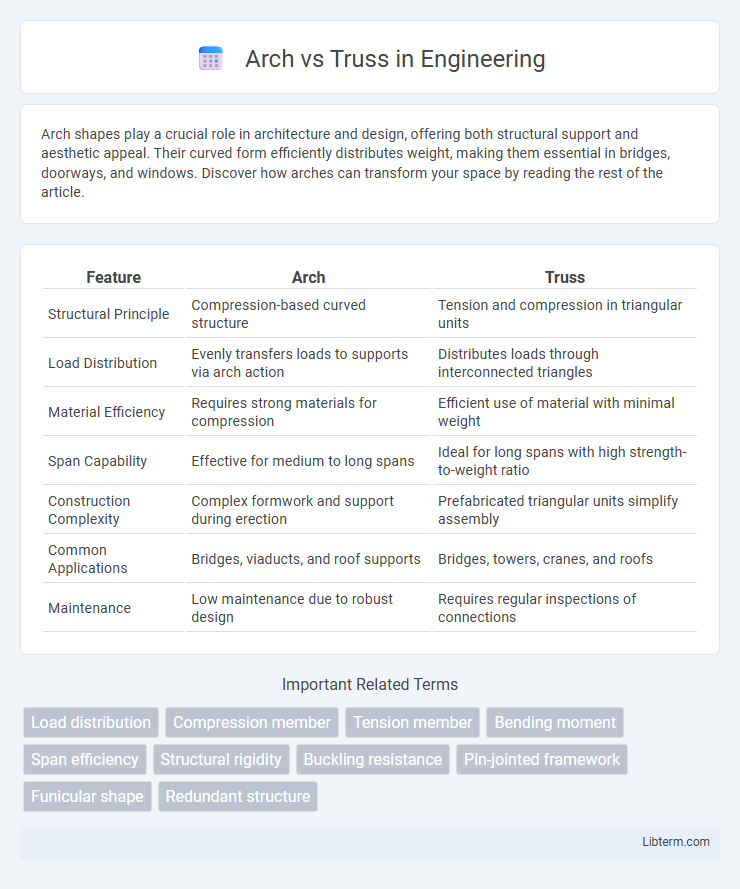Arch shapes play a crucial role in architecture and design, offering both structural support and aesthetic appeal. Their curved form efficiently distributes weight, making them essential in bridges, doorways, and windows. Discover how arches can transform your space by reading the rest of the article.
Table of Comparison
| Feature | Arch | Truss |
|---|---|---|
| Structural Principle | Compression-based curved structure | Tension and compression in triangular units |
| Load Distribution | Evenly transfers loads to supports via arch action | Distributes loads through interconnected triangles |
| Material Efficiency | Requires strong materials for compression | Efficient use of material with minimal weight |
| Span Capability | Effective for medium to long spans | Ideal for long spans with high strength-to-weight ratio |
| Construction Complexity | Complex formwork and support during erection | Prefabricated triangular units simplify assembly |
| Common Applications | Bridges, viaducts, and roof supports | Bridges, towers, cranes, and roofs |
| Maintenance | Low maintenance due to robust design | Requires regular inspections of connections |
Introduction: Understanding Arch and Truss Structures
Arch structures efficiently transfer loads through curved elements, creating compression that provides strong support for bridges and buildings. Truss structures utilize interconnected triangular units, distributing forces evenly to enhance stability and reduce material usage. Both systems optimize structural integrity by managing tension and compression in distinct geometric configurations.
Historical Development of Arches and Trusses
Arches have been a fundamental architectural element since ancient civilizations like the Romans, who perfected their use in aqueducts and bridges using precisely cut stone voussoirs to efficiently transfer loads. Trusses emerged prominently during the Industrial Revolution with advancements in iron and steel, enabling engineers to design lightweight, strong frameworks for bridges and buildings using interconnected triangular units. The evolution of both arches and trusses reflects significant technological progress in material sciences and construction techniques, shaping modern structural engineering.
Basic Principles: How Arches Work
Arches transfer loads primarily through compression, channeling forces along the curve to the supports or abutments at each end. This structural form efficiently handles weight by redistributing stress, minimizing bending moments that occur in other frameworks. The keystone at the center locks the arch in place, ensuring stability and enabling it to span large openings with minimal material.
Basic Principles: How Trusses Function
Trusses function by efficiently distributing loads through a framework of interconnected triangles, which provide stability and resist deformation. The triangular configuration allows trusses to transfer forces mainly as tension or compression along their members, minimizing bending moments. This geometric rigidity makes trusses ideal for spanning large distances while maintaining strength and reducing material use compared to arches.
Structural Materials for Arches and Trusses
Arches commonly utilize stone, reinforced concrete, or steel due to their ability to handle compressive forces effectively, whereas trusses predominantly employ steel or timber, materials that excel in tension and compression for efficient load distribution. Reinforced concrete arches benefit from the material's compressive strength and durability, while steel trusses leverage high tensile strength to create lightweight yet strong frameworks. The choice of structural material directly impacts the performance, durability, and application scope of arches and trusses in architectural and engineering projects.
Architectural Applications: Where Arches Excel
Arches excel in architectural applications requiring strong load-bearing capabilities and aesthetic appeal, such as bridges, historic cathedrals, and aqueducts. Their curved shape efficiently distributes weight, allowing for larger open spaces without the need for numerous supports. Architectural landmarks like the Roman Colosseum and Gothic cathedrals highlight arches' ability to combine structural integrity with decorative elegance.
Architectural Applications: Where Trusses Dominate
Trusses dominate architectural applications in large-span structures such as bridges, stadiums, and industrial buildings due to their efficient load distribution and material economy. Their triangular framework allows for high strength-to-weight ratios, making them ideal for supporting heavy loads over long distances without excessive deflection. The versatility in design and ease of prefabrication further establish trusses as the preferred choice for expansive roofing systems and long-span floors.
Benefits and Drawbacks: Arch vs Truss
Arch bridges offer excellent natural strength and durability by efficiently transferring loads through compression, reducing material usage and maintenance costs; however, their construction requires precise engineering and is less adaptable to longer spans. Truss bridges provide high strength-to-weight ratios and flexibility in design, allowing for longer spans and easier material sourcing, yet they often involve complex joint fabrication and higher maintenance due to numerous connections. Choosing between arch and truss bridges depends on factors like span length, load conditions, material availability, and environmental impact, with arches favored for aesthetics and durability and trusses for versatility and economic construction.
Key Design Considerations for Each System
Arch bridges excel in distributing compressive forces through their curved structure, making them ideal for spanning deep valleys or rivers with strong abutments to resist horizontal thrust. Truss bridges utilize interconnected triangular units that efficiently handle both tension and compression, allowing for longer spans with lighter materials and easy prefabrication. Key design considerations for arches include foundation strength and lateral stability, while trusses require precise joint connections and load path optimization.
Future Trends in Structural Architecture
Future trends in structural architecture emphasize the integration of Arch and Truss systems through advanced materials like carbon fiber and smart composites, enhancing load distribution and design flexibility. Digital fabrication and parametric modeling enable architects to optimize complex geometries that blend the aesthetic and functional strengths of both Arch and Truss frameworks. Sustainable construction practices prioritize adaptive structures utilizing these hybrid systems to improve energy efficiency and resilience in urban environments.
Arch Infographic

 libterm.com
libterm.com